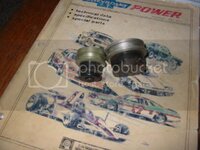CrossedFlags77
Active member
- Joined
- May 13, 2008
- Messages
- 34
can't you just drill some holes in the pads? why do we make a federal case out of everything
I was wondering the same thing. What are the advantages of dual pin?
can't you just drill some holes in the pads? why do we make a federal case out of everything
I was wondering the same thing. What are the advantages of dual pin?

The "L" at the top of and perpendicular to the backing plate is what makes these significantly stiffer than the single pin stock pads.
BTW, I thought those PoS spacers had been outlawed for competition use by just about every rule book on the planet by now. How does that get thru tech?
Anything that causes/allows uneven pressure of the pad material against the rotor is detrimental to maximum braking capability. That would include caliper bracket flex, FOD and/or gas buildup between friction surfaces, uneven piston pressures, and backing plate warpage.
i've never heard of backing plate warpage being a problem. NEVER.
The J-56 dual pin calipers also came with pistons that had insulators on them. I believe the insulators were made from a toxic material thats no longer used in the USA.
redvetracr
Probably Phenolic. Phenals are no longer used here do to toxicity issues.
Looking forward to the replies about the J56 vs stock calipers...
Thanks.

John Greenwood in his VIP article said, "For continuous, fast lap racing applications, generating sustained high temparature operation, I recommend you install the GM pistons and insulator assemblies from the old GM J56 brake option (front insulator #5463822. rear #546699593). This will help insulate the rotor heat from the brake fluid. For continuous heavy duty use I further recommend installation of the GM front caliper support brace for the J56 heavy duty brake package which bolts to the steering arm and caliper.Now a question if I may. I get the imprssion that j56/ dual pin calipers are the same as the stock ones albeit with different pistons and the mods for the cotter pin held pads. 'Twood seem that some J56 calipers might be nothing more than milled/drilled stock ones with different pistons. I"ld love to see what's inside the J56's as it should not be that hard to retrofit stockers at a much cheaper cost.
Looking forward to the replies about the J56 vs stock calipers...
Thanks.

